 It could be argued that a keyboard’s beauty lies in its simple elegance. No flashing lights, no blinking screens, no whirring eye candy, just several rows of dumb keys obediently awaiting your input.
It could be argued that a keyboard’s beauty lies in its simple elegance. No flashing lights, no blinking screens, no whirring eye candy, just several rows of dumb keys obediently awaiting your input.
Simple. Classic.
Boring.
Clear your desks for Logitech’s new Cordless Desktop MX 5000 Laser keyboard – a futuristic, gadget-tastic affair that will makes your current keyboard look more at home in a Stone Age cave.
The Bluetooth keyboard features a built-in LCD which can display a ton of useful (and not-so-useful) information including e-mail and instant message notifications, favourite playlists and Internet radio stations.
Ever found yourself typing an email to your Gran and wondering what the ambient temperature of the room was? No problem – the MX 5000’s got a built in room temperature readout.
For MP3 junkies, there’s one-touch access to music playlists from popular player like iTunes, Windows Media Player and Musicmatch, with keyboard bashers also able to access and launch categories and themes of music through Musicmatch’s Internet radio stations.
The keyboard LCD screen provides instant notification of new e-mail and instant messages and there’s also a humble calculator included, but this one’s got a clever twist, with calculation results automatically being saved to the computer’s clipboard. Neat.
Naturally, if you want indicators, the MX 5000’s got ’em, with the LCD screen keeping users informed about the vital status of the caps lock and F lock keys, volume levels and mute.
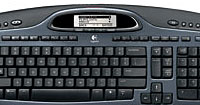 The MX5000 reflects the trend which sees dumb-as-a-rock keyboards slowly turning into smartypants devices, capable of both sending and receiving info from the computer and, in this case, even acting as a Bluetooth 2.0 Enhanced Data Rate (EDR) wireless hub.
The MX5000 reflects the trend which sees dumb-as-a-rock keyboards slowly turning into smartypants devices, capable of both sending and receiving info from the computer and, in this case, even acting as a Bluetooth 2.0 Enhanced Data Rate (EDR) wireless hub.
“Logitech introduced the world’s first mouse-and-keyboard combination in 1998 with the goal of removing cord clutter from the desk,” gushed Denis Pavillard, Logitech vice president of product marketing for desktops.
“We succeeded in delivering on that vision, and we are now addressing a different kind of clutter – cleaning up the mess of notifications and information that are displayed on the computer monitor.”
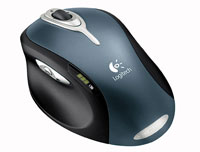 “The Logitech Cordless Desktop MX 5000 Laser desktop pushes that information to a peripheral screen so that people can choose when to glance at their notifications and status information, and can therefore clear their monitors — and their minds,” he added.
“The Logitech Cordless Desktop MX 5000 Laser desktop pushes that information to a peripheral screen so that people can choose when to glance at their notifications and status information, and can therefore clear their monitors — and their minds,” he added.
The Cordless Desktop MX 5000 package comes with Logitech’s MX1000 Cordless Laser Mouse, a laser powered chappie in a matching blue-slate/black finish.
Of course, the more functionality you squeeze into a keyboard, the greater the power needs, and Logitech have included a smart power-management solution which seems to comprise of a decidedly low tech on/off switch on the keyboard and an integrated battery indicator light.
We could have used one of them for our Logitech MX700 mouse which promptly ran out of juice half way through writing this review and is now pointlessly blinking away in its recharging dock.
The Logitech Cordless Desktop MX 5000 Laser will be available in October in the U.S. and Europe with a suggested retail price of £119.99 (€176) in Europe ($149.99 US).
Logitech
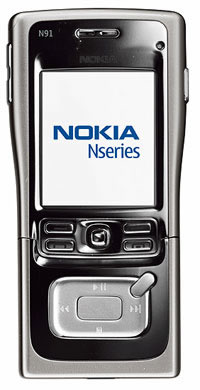 Speculation about Reuters reported than Kari Tuutti, spokesman for Nokia’s multimedia division said, “There is no commercial agreement between Nokia and Apple to integrate iTunes into the N-series devices.”
Speculation about Reuters reported than Kari Tuutti, spokesman for Nokia’s multimedia division said, “There is no commercial agreement between Nokia and Apple to integrate iTunes into the N-series devices.”  In a making-the-most-out-of-a-difficult-situation way, Kari went on to say, “But since this is based on a computer platform, anybody — including Apple if they so wish — can very easily develop this kind of application and offer it to consumers, via the Internet for example.”
In a making-the-most-out-of-a-difficult-situation way, Kari went on to say, “But since this is based on a computer platform, anybody — including Apple if they so wish — can very easily develop this kind of application and offer it to consumers, via the Internet for example.”  Fancy getting all very Mission-Impossible at home or round about? Concerned that you need to protect yourself against International terrorists, your elder brother or members of a rival spy gang?
Fancy getting all very Mission-Impossible at home or round about? Concerned that you need to protect yourself against International terrorists, your elder brother or members of a rival spy gang? 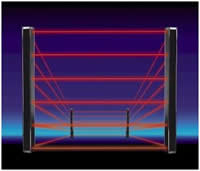 It’s an interesting adoption of technology that is used to protect really rather serious things, like armed fighter planes sitting on a runway and power stations, as
It’s an interesting adoption of technology that is used to protect really rather serious things, like armed fighter planes sitting on a runway and power stations, as 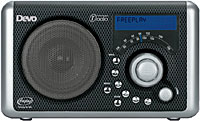 The world’s first wind-up FM and DAB digital radio, the Freeplay Devo, will be on sale in the UK soon.
The world’s first wind-up FM and DAB digital radio, the Freeplay Devo, will be on sale in the UK soon. 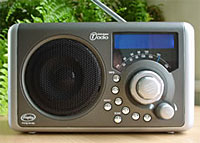 There’s a set of handy stereo RCA (phono) sockets onboard, letting users plug the radio into their home entertainment system, with a built in headphone socket for late night listening.
There’s a set of handy stereo RCA (phono) sockets onboard, letting users plug the radio into their home entertainment system, with a built in headphone socket for late night listening. 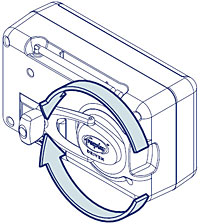 When the batteries run out, a 60-second burst of action on the wind-up lever should reward the user with 3-5 minutes DAB reception or one hour of FM pleasure at normal volume
When the batteries run out, a 60-second burst of action on the wind-up lever should reward the user with 3-5 minutes DAB reception or one hour of FM pleasure at normal volume 
 The Bush administration doesn’t appear to have taken in to account any of this, and all of a sudden are interested in the views of the people. Wouldn’t it have been great if they’d listened to the view of the people before invading Iraq.
The Bush administration doesn’t appear to have taken in to account any of this, and all of a sudden are interested in the views of the people. Wouldn’t it have been great if they’d listened to the view of the people before invading Iraq.  Toshiba claim a first with their release of what they claim is the first commercially released Perpendicular Magnetic Recording (PMR) hard drive.
Toshiba claim a first with their release of what they claim is the first commercially released Perpendicular Magnetic Recording (PMR) hard drive. 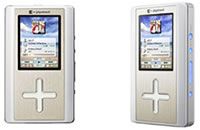 They’re also using the drive to make their Gigabeat music player sexier. The introduction of PMR technology into the Gigabeat F41 not only gives them 40Gb of storage, from a previous 20Gb, but lets them shrink the thickness by 3m.
They’re also using the drive to make their Gigabeat music player sexier. The introduction of PMR technology into the Gigabeat F41 not only gives them 40Gb of storage, from a previous 20Gb, but lets them shrink the thickness by 3m. 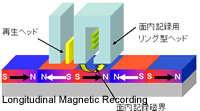 How does it work its magic? Today’s drives typically use Longitudinal Magnetic Recording (LMR). In simple terms, the difference between the two is LMR has the magnetic field pointing either left or right, while PMR has them pointing up or down. This helps to achieve higher and more stable recording densities, and in turn improves storage capacity. The images from Toshiba should help make it a bit clearer (if you happen to speak Japanese).
How does it work its magic? Today’s drives typically use Longitudinal Magnetic Recording (LMR). In simple terms, the difference between the two is LMR has the magnetic field pointing either left or right, while PMR has them pointing up or down. This helps to achieve higher and more stable recording densities, and in turn improves storage capacity. The images from Toshiba should help make it a bit clearer (if you happen to speak Japanese).  While the theory of PMR has been around for a number of years, Toshiba has taken 1-2 quarters longer than they’d expected in getting the MK4007GAL to market.
While the theory of PMR has been around for a number of years, Toshiba has taken 1-2 quarters longer than they’d expected in getting the MK4007GAL to market.  Amazon is testing its new A9 mapping service that lets users view street-level photos of city blocks surrounding a requested address.
Amazon is testing its new A9 mapping service that lets users view street-level photos of city blocks surrounding a requested address.  Amazon first introduced street-level photographs of specific addresses as part of its Yellow Pages listings, but the company believes that consumers will find the A9 service a more helpful view than Google mappings satellite views.
Amazon first introduced street-level photographs of specific addresses as part of its Yellow Pages listings, but the company believes that consumers will find the A9 service a more helpful view than Google mappings satellite views.  Not surprisingly, the horizon-challenged photographs ably illustrate that there’s none of Bresson’s magic in evidence, with pictures being automatically snapped by trucks equipped with digital cameras and GPS, receivers.
Not surprisingly, the horizon-challenged photographs ably illustrate that there’s none of Bresson’s magic in evidence, with pictures being automatically snapped by trucks equipped with digital cameras and GPS, receivers. 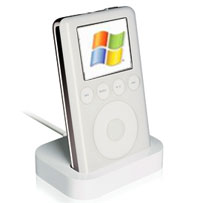 Apple may be forced to shell out royalties to Microsoft for every single iPod it sells after it emerged that Microsoft was first to file a crucial patent on technology used in its iPod.
Apple may be forced to shell out royalties to Microsoft for every single iPod it sells after it emerged that Microsoft was first to file a crucial patent on technology used in its iPod. 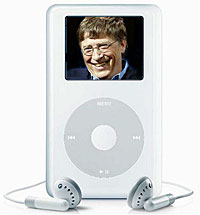 The application doesn’t identify the iPod by name (usual for such petitions), describing a “portable, pocket-sized multimedia asset player” capable of managing MP3 music files including “a song title, a song artist, a song album, a song length”
The application doesn’t identify the iPod by name (usual for such petitions), describing a “portable, pocket-sized multimedia asset player” capable of managing MP3 music files including “a song title, a song artist, a song album, a song length”  It seems that there’s a never ending supply of companies ready to shell out for surveys asking the most inane questions.
It seems that there’s a never ending supply of companies ready to shell out for surveys asking the most inane questions.  Plundering the depths of inanity further, the survey revealed that 34 per cent of females ranked spouse emails as the most important, and 10 per cent more blokes reckoned mobile email would make their lives easier. Fascinating.
Plundering the depths of inanity further, the survey revealed that 34 per cent of females ranked spouse emails as the most important, and 10 per cent more blokes reckoned mobile email would make their lives easier. Fascinating.  It could be argued that a keyboard’s beauty lies in its simple elegance. No flashing lights, no blinking screens, no whirring eye candy, just several rows of dumb keys obediently awaiting your input.
It could be argued that a keyboard’s beauty lies in its simple elegance. No flashing lights, no blinking screens, no whirring eye candy, just several rows of dumb keys obediently awaiting your input.  The MX5000 reflects the trend which sees dumb-as-a-rock keyboards slowly turning into smartypants devices, capable of both sending and receiving info from the computer and, in this case, even acting as a Bluetooth 2.0 Enhanced Data Rate (EDR) wireless hub.
The MX5000 reflects the trend which sees dumb-as-a-rock keyboards slowly turning into smartypants devices, capable of both sending and receiving info from the computer and, in this case, even acting as a Bluetooth 2.0 Enhanced Data Rate (EDR) wireless hub.  “The Logitech Cordless Desktop MX 5000 Laser desktop pushes that information to a peripheral screen so that people can choose when to glance at their notifications and status information, and can therefore clear their monitors — and their minds,” he added.
“The Logitech Cordless Desktop MX 5000 Laser desktop pushes that information to a peripheral screen so that people can choose when to glance at their notifications and status information, and can therefore clear their monitors — and their minds,” he added.  The UK market for online shopping looks set to soar to £60 billion (~€88 billion, US$108 billion~) by 2010 according to a new report.
The UK market for online shopping looks set to soar to £60 billion (~€88 billion, US$108 billion~) by 2010 according to a new report. 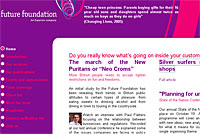 The Future Foundation commented that websites sporting yoof-orientated design, teensy weensy text and kray-zee interfaces are likely to miss out on silver surfer sales.
The Future Foundation commented that websites sporting yoof-orientated design, teensy weensy text and kray-zee interfaces are likely to miss out on silver surfer sales.